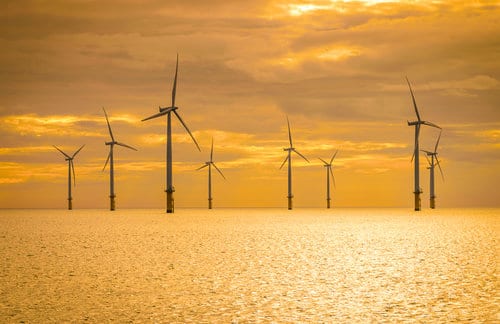
In its 2016 annual Budget, the UK government announced plans to allocate GBP 730m ($1bn) by 2021 to offshore wind farms and other less-established renewable energy technologies, sticking to its low-carbon commitment while moving support away from the more established technologies of onshore wind and solar PV.
A series of auctions will be held over the next few years to allocate the funding, with a requirement to hit tightening price targets for offshore wind as the auction programme unfolds.
Project developers bidding in the first GBP 290m auction set for this year will need to meet a price cap of GBP 105/MWh to be in with a chance of winning support. The 4GW cap also means that “only a third of the estimated 12GW offshore wind pipeline to 2026 could be supported, if offshore wind were to win all the subsidy allocated,” according to BNEF forecasts, as detailed in an Analyst Reaction on the UK 2016 Budget.
Vattenfall’s planned development of two projects totaling 3.6GW of capacity in the UK’s North Sea highlights the likely degree of interest in offshore wind tenders. The Swedish utility’s 1.8GW Norfolk Vanguard and 1.8GW Norfolk Boreas projects are both advancing into planning stages, and would take up most the capacity likely to be available if they were to both win tenders in the government auctions.
The UK Treasury also set aside GBP 50m for energy storage research and another GBP 30m for small-scale nuclear reactors, but did not say whether onshore wind and solar will be eligible to participate in future Contracts for Difference auctions. The Budget also faced criticism for abolishing a tax on petroleum revenue on profits from oil and gas production, and scrapping the Carbon Reduction Commitment – a mandatory report on emissions from large companies.
Vacuum cleaner specialist Dyson was one company benefitting from the UK Budget announcement, as it expands into new sectors following its acquisition of Satki3, a US maker of solid-state lithium-ion batteries. The UK producer of vacuum cleaners received a GBP 16m grant to contribute to its GBP 1bn ($1.4bn) investment in battery development over the next five years.
Chancellor of the Exchequer George Osborne also gave the green light last week to autonomous car testing on UK motorways, in a push to make driverless technology available to consumers by the end of the decade. The decision follows recent industry moves by three of the world’s largest automakers in the realms of intelligent mobility. General Motors will acquire self-driving systems developer, Cruise Automation, later this year; Ford has established a new unit focused entirely on autonomous vehicles; and a team of 16 robotics software engineers have joined Toyota’s research institute. The implication of these investments is discussed in this Analyst Reaction.
In the US, automakers and regulators are working towards a voluntary agreement to equip new cars and trucks with automatic emergency braking systems, designed to detect and prevent crashes, without driver action. Ford, Toyota and Volkswagen are among companies funding artificial intelligence research at the University of California at Berkeley, in a bid to stay abreast of the latest technology to commercialise in their self-driving cars.
Elsewhere in Europe, wind turbine maker Senvion is taking its second strike at an IPO, reducing the cost of its shares by 23% on the prices touted previously. The Hamburg-based wind manufacturer plans to sell 16.25m shares to investors for EUR 15.50 to EUR 17 apiece, together with an over-allotment of almost 2.4m shares. The issue would raise at least EUR 250m ($357m) at that price.
Senvion’s private placement, “coincides with a period of consolidation in the market, with Nordex’s recent acquisition of Acciona Windpower, GE’s acquisition of Alstom, and Siemens’ mooted purchase of Gamesa, as manufacturers attempt to expand their global presence and diversify product offerings,” said a BNEF analyst.
In emerging markets, Goldman Sachs-backed ReNew Power Ventures won the rights to build 522MW of solar projects in east India last week, in a state tender auctioning rights to develop 1.2GW of power. Overseas Private Investment Corporation, or OPIC, the US government’s development finance institution, has since announced it will lend $250m in long-term debt to the Indian clean energy company, which started out as a wind energy producer and is expanding its portfolio into solar.
In Africa, the 310MW Lake Turkana wind project in Kenya will face a setback in supplying power to the grid when it goes live in October, according to project developer Lake Turkana Wind Power. This is due to delays in the construction of 428km of power lines that will transmit power from the project location in remote northern Kenya to cities in the country’s south.
Subsidy status of UK offshore wind pipeline, 2017 to 2026 (GW of capacity)

The UK’s 4GW capacity cap will mean that only a third of the estimated 12GW pipeline to 2026 could be supported, if offshore wind were to win all the subsidy allocated. This is represented in blue in the graph above. The wording of the Budget implies that subsidy savings from auctions closing at below strike prices might not be re-allocated to fit in additional megawatts past the 4GW mark.
Source: Bloomberg New Energy Finance. Reproduced with permission.






